Segmenting Individual Tree from TLS Point Clouds Using Improved DBSCAN
Abstract
:1. Introduction
2. Methods and Materials
2.1. Trunk Detection
2.1.1. Generate the Optimal Parameters Based on DDM
2.1.2. Improved DBSCAN Algorithm Flow
2.1.3. Eliminate Noise Points Based on Hough Circle Detection
2.2. Region Growth Layer-by-Layer Clustering
2.3. Materials
2.3.1. Mixed Forests of TLS Point Clouds in Germany
2.3.2. Artificial Forest of TLS Point Clouds in China
2.4. Evaluation Methods
3. Results and Analysis
3.1. Results of Individual Tree Segmentation
3.1.1. Overall Segmentation Result
3.1.2. Trunk Detection Results
3.1.3. Small Tree Detection Results
3.2. Comparison with Traditional DBSCAN Method
3.3. Comparison with CHM Method
3.4. Comparison with Zhong’s Method
4. Discussion
4.1. Optimization Verification of Parameters Automatically Obtained
4.2. Analysis of Small Tree Detection Results
4.3. Individual Tree Segmentation Analysis of Complex Forest
5. Conclusions
Author Contributions
Funding
Data Availability Statement
Conflicts of Interest
Appendix A
References
- Cabo, C.; Ordóñez, C.; López-Sánchez, C.A.; Armesto, J. Automatic dendrometry: Tree detection, tree height and diameter estimation using terrestrial laser scanning. Int. J. Appl. Earth Obs. Geoinf. 2018, 69, 164–174. [Google Scholar] [CrossRef]
- Chen, W.; Xiang, H.B.; Moriya, K. Individual Tree Position Extraction and Structural Parameter Retrieval Based on Airborne LiDAR Data: Performance Evaluation and Comparison of Four Algorithms. Remote Sens. 2020, 12, 571. [Google Scholar] [CrossRef] [Green Version]
- Rudge, M.L.M.; Levick, S.R.; Bartolo, R.E.; Erskine, P.D. Modelling the Diameter Distribution of Savanna Trees with Drone-Based LiDAR. Remote Sens. 2021, 13, 1266. [Google Scholar] [CrossRef]
- Fan, G.; Nan, L.; Dong, Y.; Su, X.; Chen, F. AdQSM: A New Method for Estimating Above-Ground Biomass from TLS Point Clouds. Remote Sens. 2020, 12, 3089. [Google Scholar] [CrossRef]
- Zheng, Y.; Jia, W.; Wang, Q.; Huang, X. Deriving Individual-Tree Biomass from Effective Crown Data Generated by Terrestrial Laser Scanning. Remote Sens. 2019, 11, 2793. [Google Scholar] [CrossRef] [Green Version]
- Yu, R.; Luo, Y.; Zhou, Q.; Zhang, X.; Wu, D.; Ren, L. A machine learning algorithm to detect pine wilt disease using UAV-based hyperspectral imagery and LiDAR data at the tree level. Int. J. Appl. Earth Obs. Geoinf. 2021, 101, 102363. [Google Scholar] [CrossRef]
- Yang, J.; Kang, Z.; Cheng, S.; Yang, Z.; Akwensi, P.H. An individual tree segmentation method based on watershed algorithm and three-dimensional spatial distribution analysis from airborne LiDAR point clouds. IEEE J. Sel. Top. Appl. Earth Obs. Remote Sens. 2020, 13, 1055–1067. [Google Scholar] [CrossRef]
- Disney, M.I.; Boni Vicari, M.; Burt, A.; Calders, K.; Lewis, S.L.; Raumonen, P.; Wilkes, P. Weighing trees with lasers: Advances, challenges and opportunities. Interface Focus. 2018, 8, 20170048. [Google Scholar] [CrossRef] [Green Version]
- Xu, D.; Wang, H.; Xu, W.; Luan, Z.; Xu, X. LiDAR Applications to Estimate Forest Biomass at Individual Tree Scale: Opportunities, Challenges and Future Perspectives. Forests 2021, 12, 550. [Google Scholar] [CrossRef]
- Liang, X.; Hyyppä, J.; Kaartinen, H.; Lehtomäki, M.; Pyörälä, J.; Pfeifer, N.; Wang, Y. International benchmarking of terrestrial laser scanning approaches for forest inventories. ISPRS J. Photogramm. Remote Sens. 2018, 144, 137–179. [Google Scholar] [CrossRef]
- Zhong, L.; Cheng, L.; Xu, H.; Chen, Y.; Li, M. Segmentation of individual trees from TLS and MLS data. IEEE J. Sel. Top. Appl. Earth Obs. Remote Sens. 2016, 10, 774–787. [Google Scholar] [CrossRef]
- Hillman, S.; Wallace, L.; Reinke, K.; Jones, S. A comparison between TLS and UAS LiDAR to represent eucalypt crown fuel characteristics. ISPRS J. Photogramm. Remote Sens. 2021, 181, 295–307. [Google Scholar] [CrossRef]
- Tao, S.; Wu, F.; Guo, Q.; Wang, Y.; Li, W. Segmenting tree crowns from terrestrial and mobile LiDAR data by exploring ecological theories. ISPRS J. Photogramm. Remote Sens. 2015, 110, 66–76. [Google Scholar] [CrossRef] [Green Version]
- Paris, C.; Kelbe, D.; Van Aardt, J.; Bruzzone, L. A novel automatic method for the fusion of ALS and TLS LiDAR data for robust assessment of tree crown structure. IEEE Trans. Geosci. Remote Sens. 2017, 55, 3679–3693. [Google Scholar] [CrossRef]
- Lu, X.; Guo, Q.; Li, W.; Flanagan, J. A bottom-up approach to segment individual deciduous trees using leaf-off lidar point cloud data. ISPRS J. Photogramm. Remote Sens. 2014, 94, 1–12. [Google Scholar] [CrossRef]
- Ayrey, E.; Fraver, S.; Kershaw, J.A., Jr.; Kenefic, L.S.; Hayes, D.; Weiskittel, A.R.; Roth, B.E. Layer Stacking: A Novel Algorithm for Individual Forest Tree Segmentation from LiDAR Point Clouds. Can. J. Remote Sens. 2017, 43, 16–27. [Google Scholar] [CrossRef]
- Khosravipour, A.; Skidmore, A.K.; Isenburg, M.; Wang, T.; Hussin, Y.A. Generating Pit-free Canopy Height Models from Airborne Lidar. Photogramm. Eng. Remote Sens. 2014, 80, 863–872. [Google Scholar] [CrossRef]
- Morsdorf, F.; Meier, E.; Kötz, B.; Itten, K.I.; Dobbertin, M.; Allgower, B. LIDAR-based geometric reconstruction of boreal type forest stands at single tree level for forest and wildland fire management. Remote Sens. Environ. 2004, 92, 353–362. [Google Scholar] [CrossRef]
- Jakubowski, M.; Li, W.; Guo, Q.; Kelly, M. Delineating individual trees from LiDAR data: A comparison of vector-and raster-based segmentation approaches. Remote Sens. 2013, 5, 4163–4186. [Google Scholar] [CrossRef] [Green Version]
- Yang, Q.; Su, Y.; Jin, S.; Kelly, M.; Hu, T.; Ma, Q.; Li, Y.; Song, S.; Zhang, J.; Xu, G.; et al. The Influence of Vegetation Characteristics on Individual Tree Segmentation Methods with Airborne LiDAR Data. Remote Sens. 2019, 11, 2880. [Google Scholar] [CrossRef] [Green Version]
- Wu, B.; Yu, B.; Yue, W.; Shu, S.; Tan, W.; Hu, C.; Huang, Y.; Wu, J.; Liu, H. A voxel-based method for automated identification and morphological parameters estimation of individual street trees from mobile laser scanning data. Remote Sens. 2013, 5, 584–611. [Google Scholar] [CrossRef] [Green Version]
- Lee, H.; Slatton, K.C.; Roth, B.E.; Cropper, W.P. Adaptive clustering of airborne LiDAR data to segment individual tree crowns in managed pine forests. Int. J. Remote Sens. 2010, 31, 117–139. [Google Scholar] [CrossRef]
- Xing, W.; Xing, Y.; Huang, Y.; Qu, L.; You, H. Individual tree segmentation of TLS point cloud data based on clustering of voxels layer by layer. J. Cent. South Univ. For. Technol. 2017, 37, 58–64. [Google Scholar]
- Comesaña-Cebral, L.; Martínez-Sánchez, J.; Lorenzo, H.; Arias, P. Individual Tree Segmentation Method Based on Mobile Backpack LiDAR Point Clouds. Sensors 2021, 21, 6007. [Google Scholar] [CrossRef] [PubMed]
- Nguyen, H.T.; Lee, E.; Bae, C.H.; Lee, S. Multiple Object Detection Based on Clustering and Deep Learning Methods. Sensors 2020, 20, 4424. [Google Scholar] [CrossRef]
- Kim, J.; Choi, J.; Yoo, K.; Nasridinov, A. AA-DBSCAN: An approximate adaptive DBSCAN for finding clusters with varying densities. J. Supercomput. 2019, 75, 142–169. [Google Scholar] [CrossRef]
- Chen, X.; Xi, Q. Research and Implementation of Adaptive Clustering Algorithm based on DBSCAN. J. Huaiyin Teach. Coll. 2021, 20, 228–234. [Google Scholar]
- Li, W.; Yan, S.; Jiang, Y.; Zhang, S.; Wang, C. Research on Method of Self-Adaptive Determination of DBSCAN Algorithm Parameters. Comput. Eng. Appl. 2019, 55, 1–7. [Google Scholar]
- Chen, Q.; Wang, X.; Hang, M.; Li, J. Research on the improvement of single tree segmentation algorithm based on airborne LiDAR point cloud. Open Geosci. 2021, 13, 705–716. [Google Scholar] [CrossRef]
- Feng, J.; Li, Z.; Rong, Y.; Sun, Z. Identification of mature tomatoes based on an algorithm of modified circle Hough transform. J. Chin. Agric. Mech. 2021, 42, 190–196. [Google Scholar]
- Li, W.; Guo, Q.; Jakubowski, M.K.; Kelly, M. A New Method for Segmenting Individual Trees from the Lidar Point Cloud. Photogramm. Eng. Remote Sens. 2012, 78, 75–84. [Google Scholar] [CrossRef] [Green Version]
- Weiser, H.; Schäfer, J.; Winiwarter, L. Terrestrial, UAV-borne, and airborne laser scanning point clouds of central European forest plots, Germany, with extracted individual trees and manual forest inventory measurements. PANGAEA 2021. [Google Scholar] [CrossRef]
- Fan, G.; Nan, L.; Chen, F.; Dong, Y.; Wang, Z.; Li, H.; Chen, D. A new quantitative approach to tree attributes estimation based on LiDAR point clouds. Remote Sens. 2020, 12, 1779. [Google Scholar] [CrossRef]
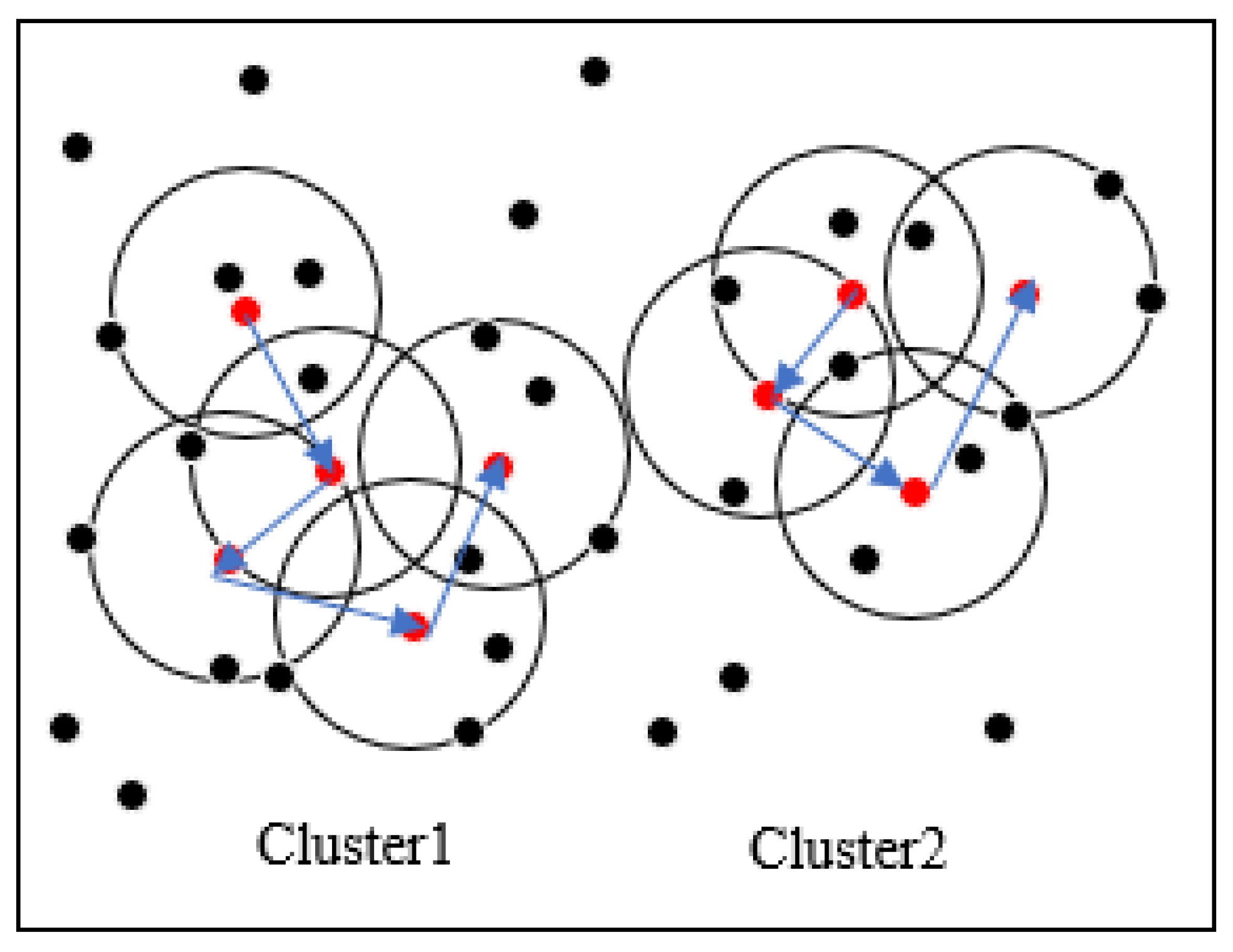
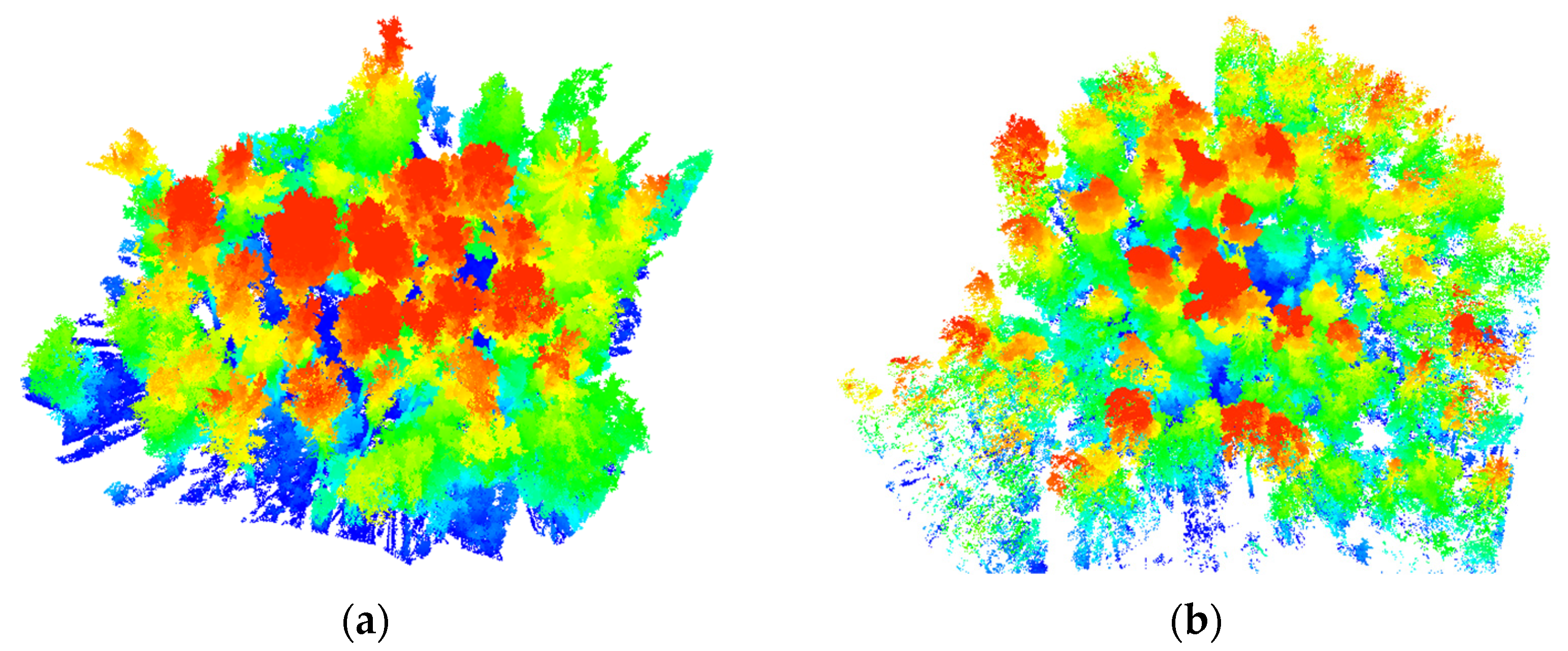

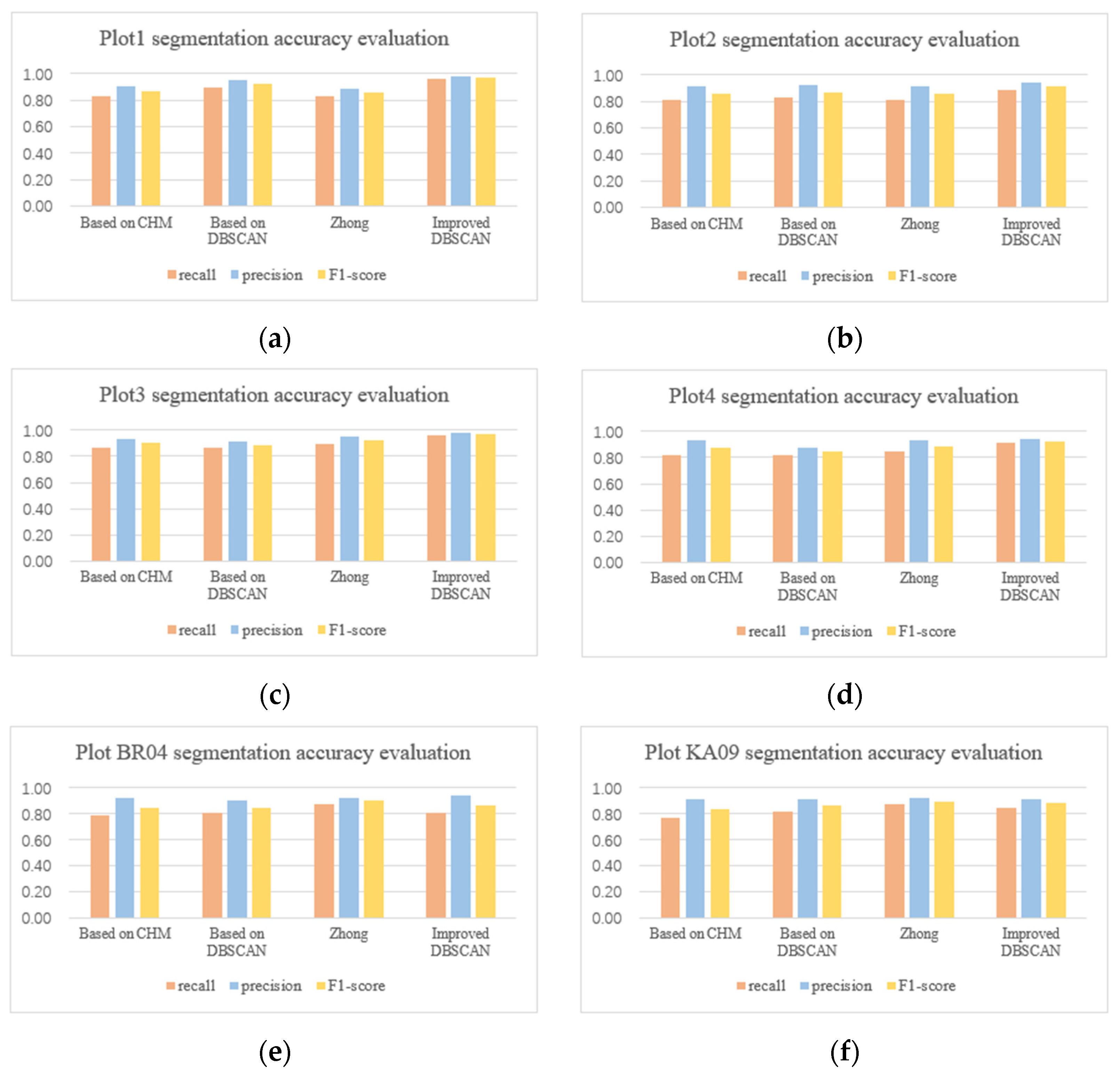
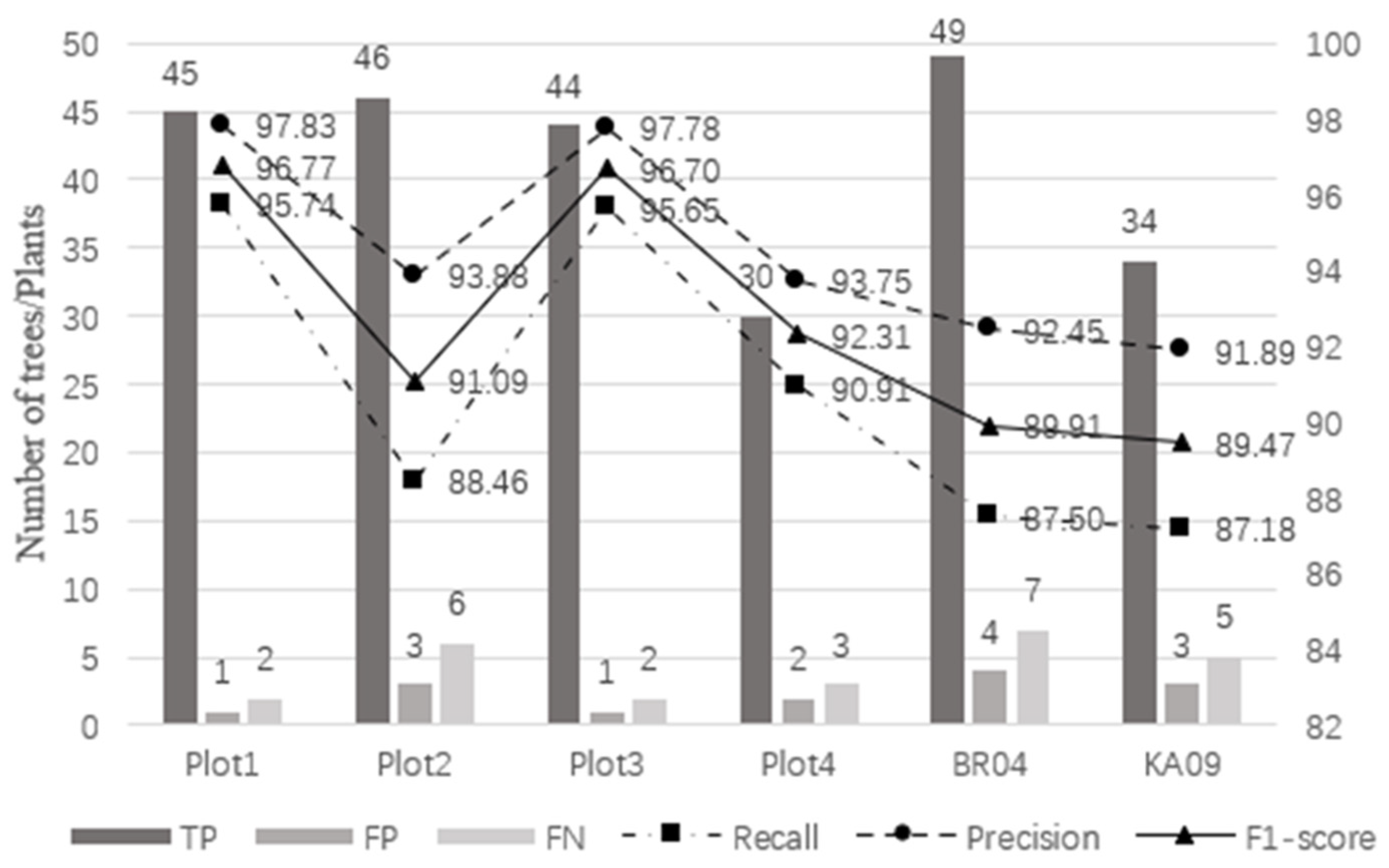
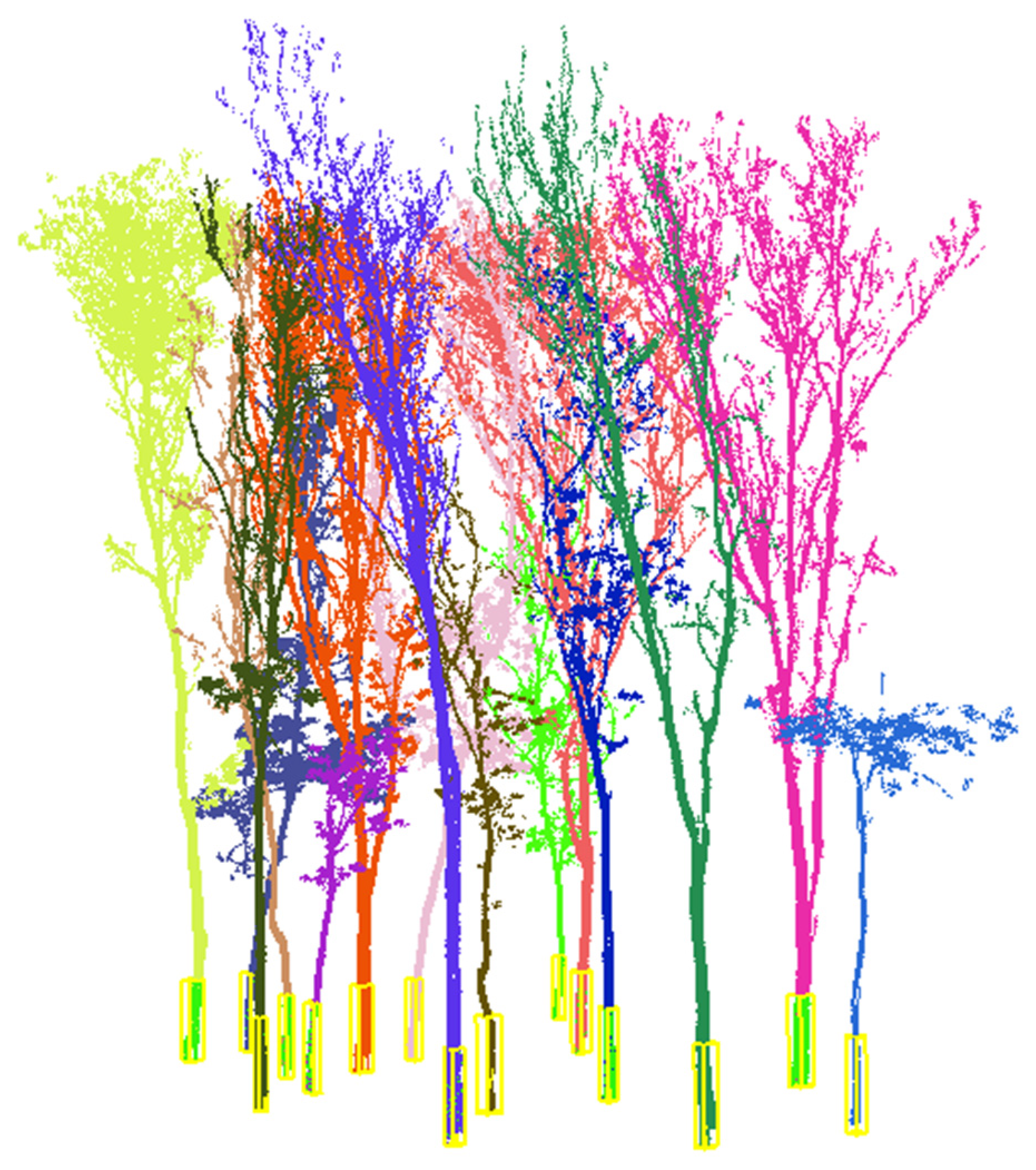
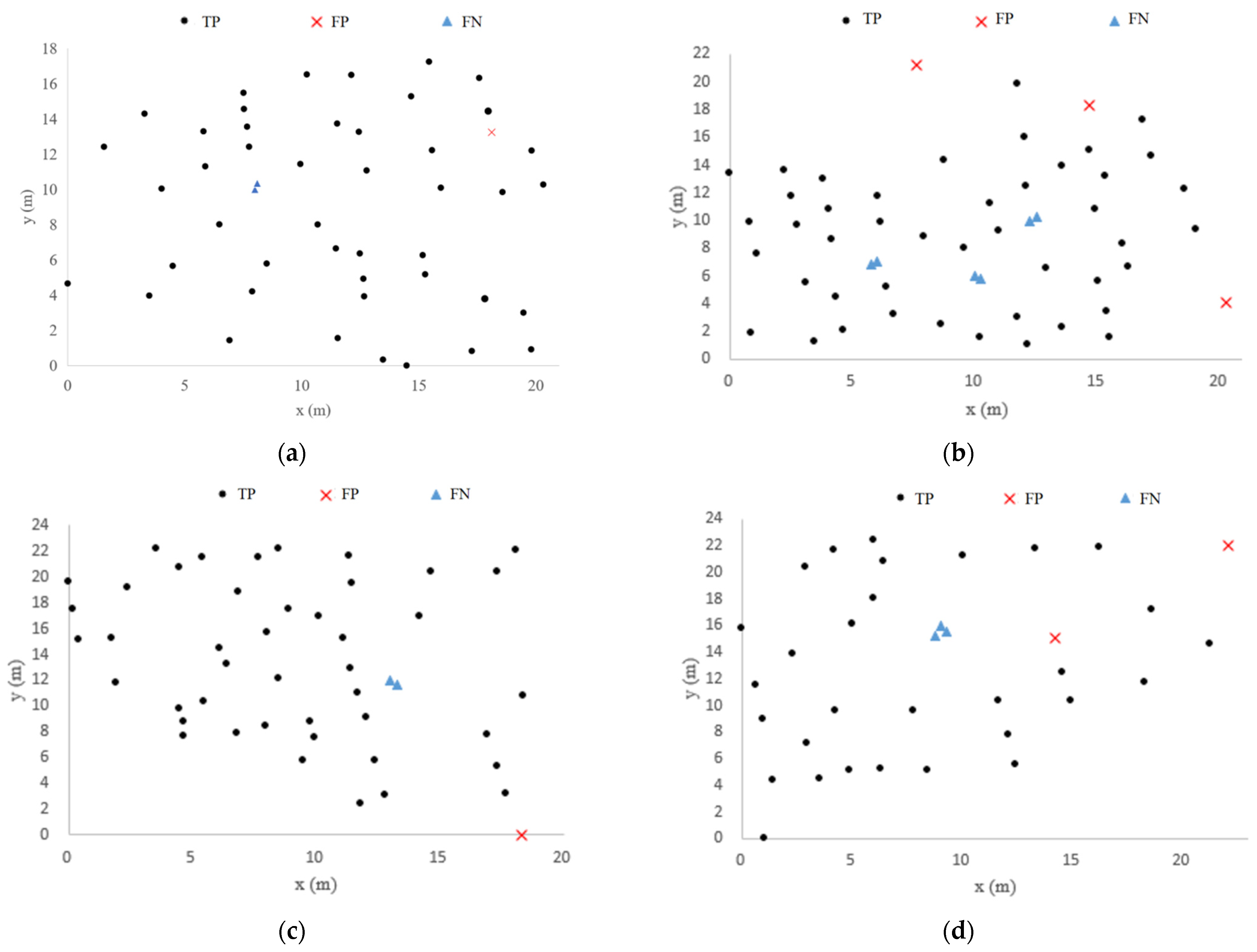
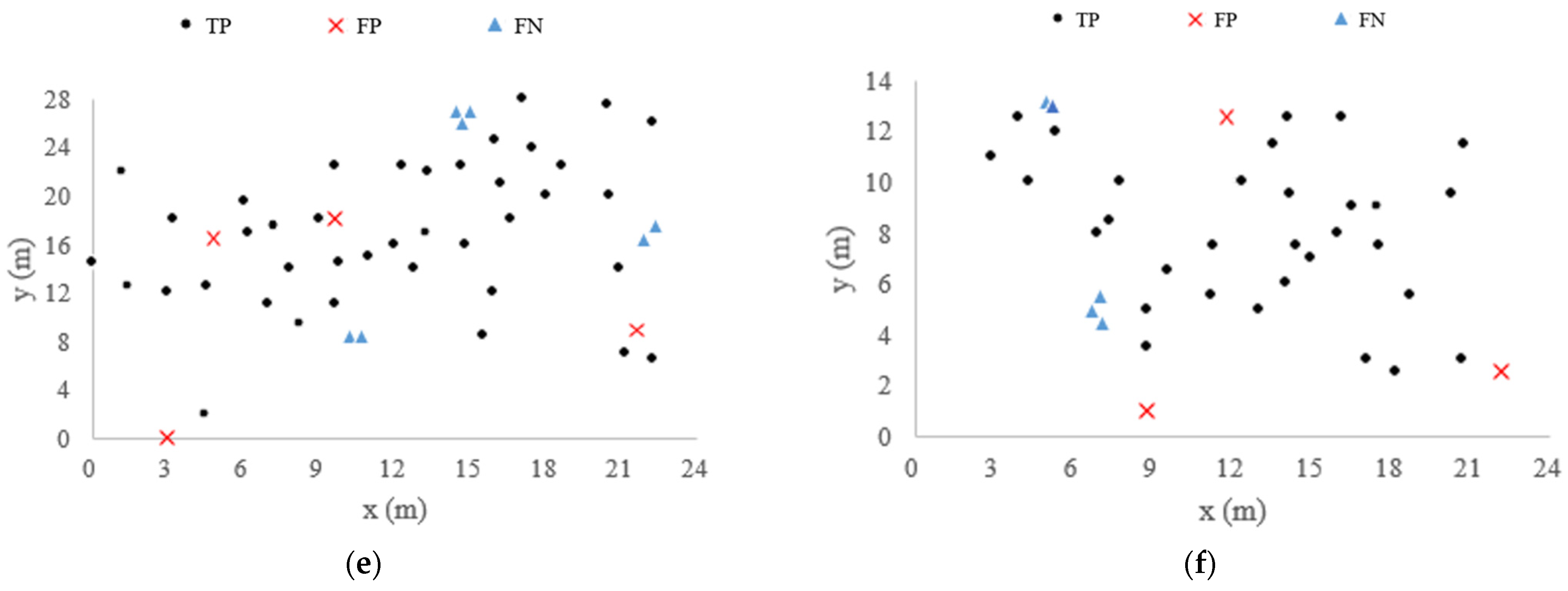

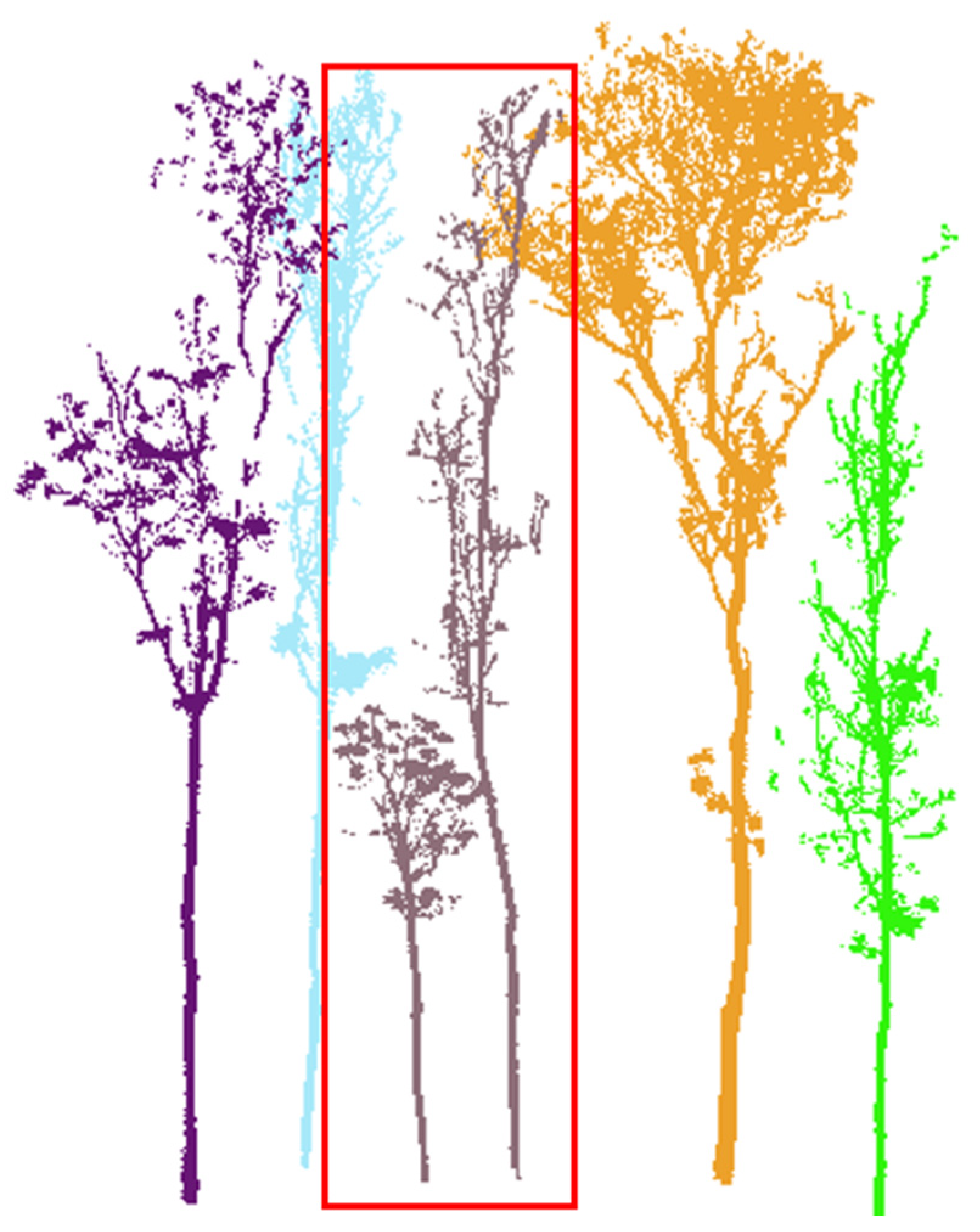

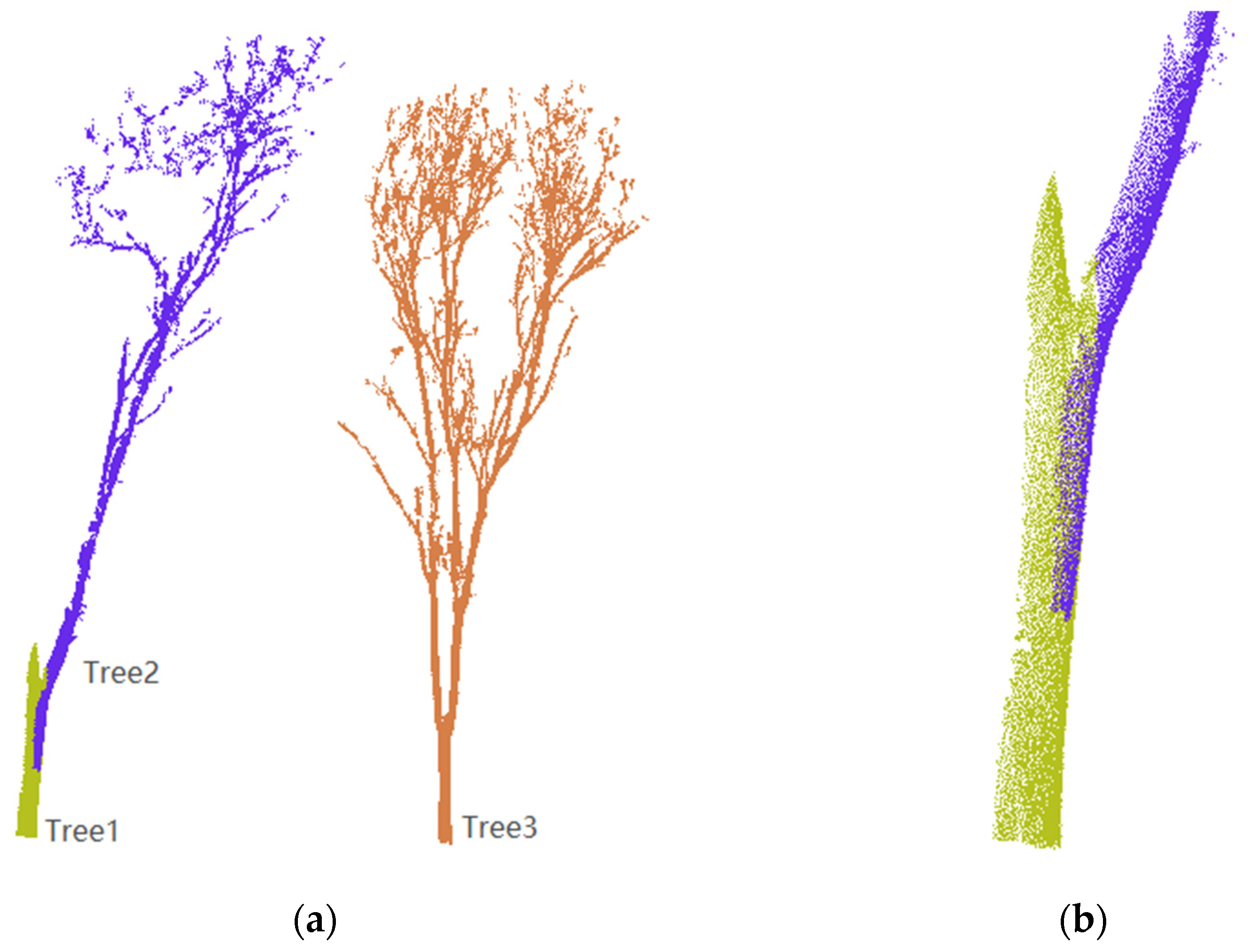
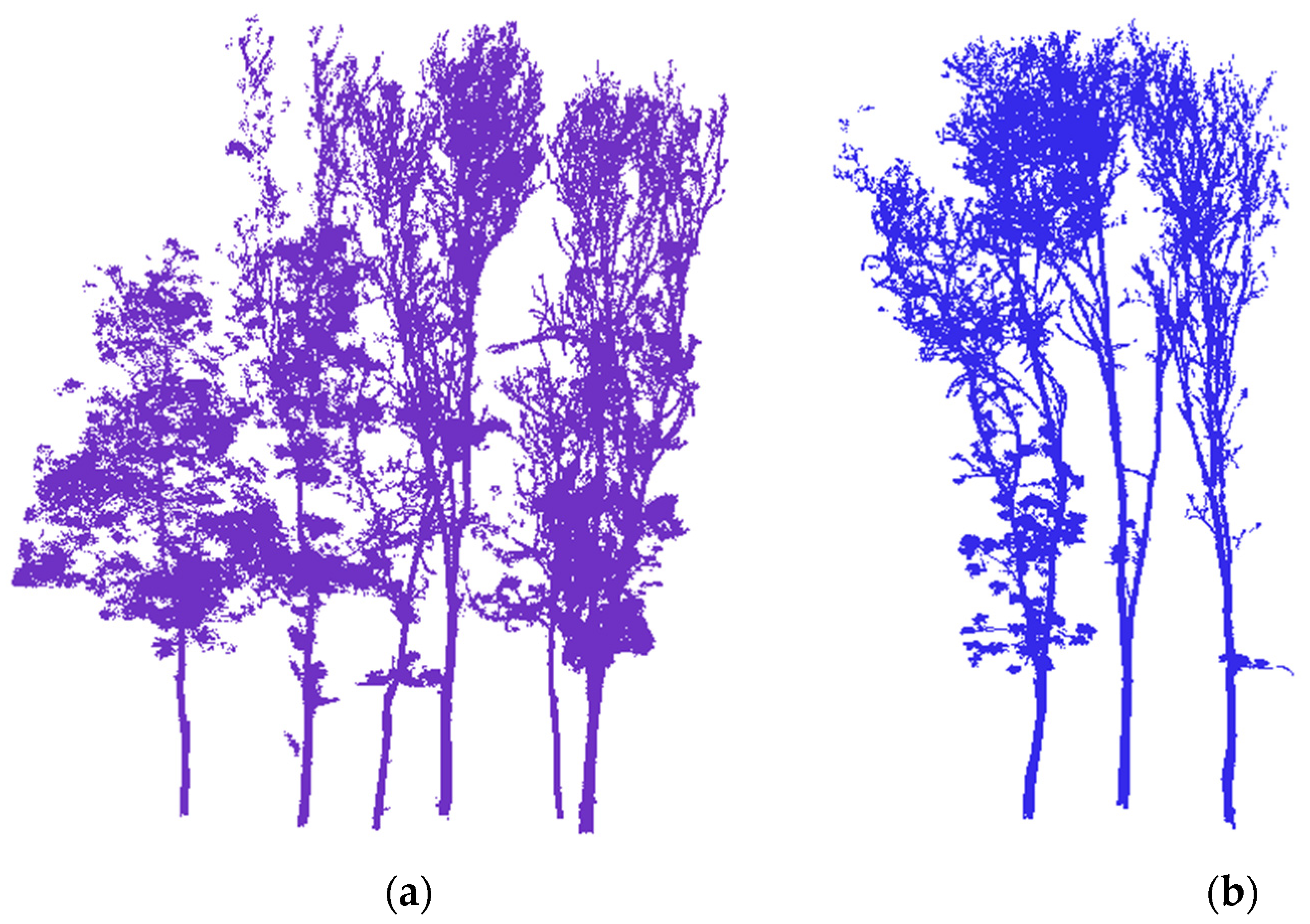
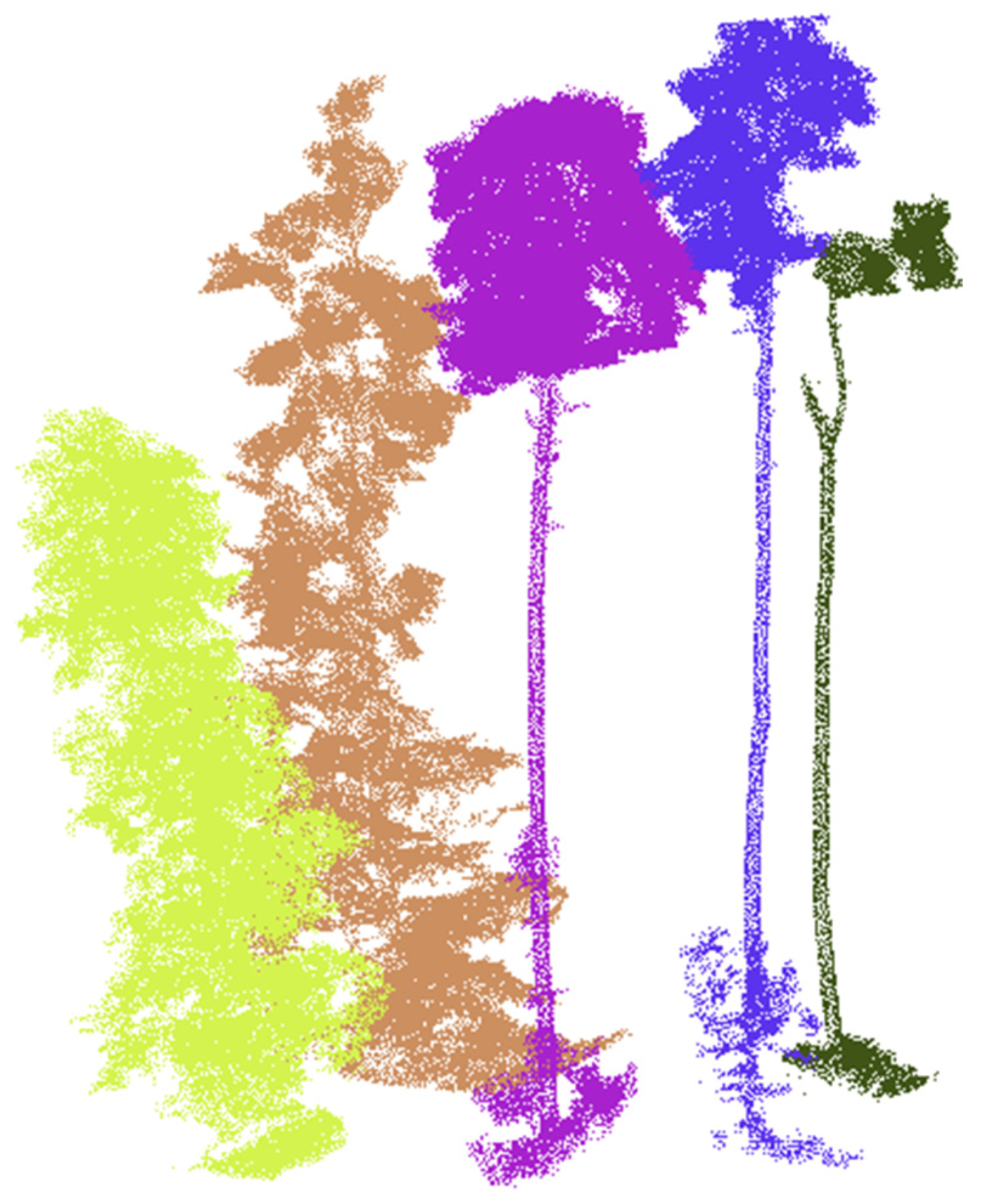
| Plot | Actual Tree Number | TP | FP | FN | Recall (%) | Precision (%) | F1-Score |
|---|---|---|---|---|---|---|---|
| Plot 1 | 47 | 42 | 2 | 5 | 89.36 | 95.45 | 0.92 |
| Plot 2 | 52 | 43 | 4 | 9 | 82.69 | 91.49 | 0.87 |
| Plot 3 | 46 | 40 | 4 | 6 | 86.96 | 90.91 | 0.89 |
| Plot 4 | 33 | 27 | 4 | 6 | 81.82 | 87.10 | 0.84 |
| Total artificial forest | 178 | 152 | 14 | 26 | 85.39 | 91.57 | 0.88 |
| BR04 | 56 | 45 | 5 | 11 | 80.36 | 90.00 | 0.85 |
| KA09 | 39 | 32 | 3 | 7 | 82.05 | 91.43 | 0.86 |
| Total mixed forest | 95 | 77 | 8 | 18 | 81.05 | 90.59 | 0.86 |
| Total | 273 | 229 | 22 | 44 | 83.88 | 91.24 | 0.87 |
| Plot | Actual Tree Number | TP | FP | FN | Recall (%) | Precision (%) | F1-Score |
|---|---|---|---|---|---|---|---|
| Plot 1 | 47 | 39 | 4 | 8 | 82.98 | 90.70 | 0.87 |
| Plot 2 | 52 | 42 | 4 | 10 | 80.77 | 91.30 | 0.86 |
| Plot 3 | 46 | 40 | 3 | 6 | 86.96 | 93.02 | 0.90 |
| Plot 4 | 33 | 27 | 2 | 6 | 81.82 | 93.10 | 0.87 |
| Total artificial forest | 178 | 148 | 13 | 30 | 83.15 | 91.93 | 0.87 |
| BR04 | 56 | 44 | 4 | 12 | 78.57 | 91.67 | 0.85 |
| KA09 | 39 | 30 | 3 | 9 | 76.92 | 90.91 | 0.83 |
| Total mixed forest | 95 | 74 | 7 | 21 | 77.89 | 91.36 | 0.84 |
| Total | 273 | 222 | 20 | 51 | 81.32 | 91.74 | 0.86 |
| Plot | Actual Tree Number | TP | FP | FN | Recall (%) | Precision (%) | F1-Score |
|---|---|---|---|---|---|---|---|
| Plot 1 | 47 | 39 | 5 | 8 | 82.98 | 88.64 | 0.86 |
| Plot 2 | 52 | 42 | 4 | 10 | 80.77 | 91.30 | 0.86 |
| Plot 3 | 46 | 41 | 2 | 5 | 89.13 | 95.35 | 0.92 |
| Plot 4 | 33 | 28 | 2 | 5 | 84.85 | 93.33 | 0.89 |
| Total artificial forest | 178 | 150 | 13 | 28 | 84.27 | 92.02 | 0.88 |
| BR04 | 56 | 45 | 3 | 11 | 80.36 | 93.75 | 0.87 |
| KA09 | 39 | 33 | 3 | 6 | 84.62 | 91.67 | 0.88 |
| Total mixed forest | 95 | 78 | 6 | 17 | 82.11 | 92.86 | 0.87 |
| Total | 273 | 228 | 19 | 45 | 83.52 | 92.31 | 0.88 |
Publisher’s Note: MDPI stays neutral with regard to jurisdictional claims in published maps and institutional affiliations. |
© 2022 by the authors. Licensee MDPI, Basel, Switzerland. This article is an open access article distributed under the terms and conditions of the Creative Commons Attribution (CC BY) license (https://creativecommons.org/licenses/by/4.0/).
Share and Cite
Fu, H.; Li, H.; Dong, Y.; Xu, F.; Chen, F. Segmenting Individual Tree from TLS Point Clouds Using Improved DBSCAN. Forests 2022, 13, 566. https://doi.org/10.3390/f13040566
Fu H, Li H, Dong Y, Xu F, Chen F. Segmenting Individual Tree from TLS Point Clouds Using Improved DBSCAN. Forests. 2022; 13(4):566. https://doi.org/10.3390/f13040566
Chicago/Turabian StyleFu, Hongping, Hao Li, Yanqi Dong, Fu Xu, and Feixiang Chen. 2022. "Segmenting Individual Tree from TLS Point Clouds Using Improved DBSCAN" Forests 13, no. 4: 566. https://doi.org/10.3390/f13040566
APA StyleFu, H., Li, H., Dong, Y., Xu, F., & Chen, F. (2022). Segmenting Individual Tree from TLS Point Clouds Using Improved DBSCAN. Forests, 13(4), 566. https://doi.org/10.3390/f13040566







